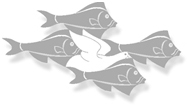

|
|
|
|
V. Ostromoukhov
Ph.D. Thesis No. 1330, EPFL, 1995
In the printing industry, one of the most common methods for reproducing halftone images using bilevel printing devices is clustered-dot ordered dithering. The images produced using this method are quite faithful to the original and are visually pleasing. Nevertheless, only rational angles are attainable with clustered-dot dithering, due to the discrete nature of the grids. This phenomenon can become detrimental in the case of four-color printing, when different screen angles and maybe even different screen frequencies are used for separate color planes, thus producing a so-called Moiré phenomenon. Another important drawback, the so-called banding or contouring effect, is related to the limited area of basic screen elements used in traditional dithering.
In order to deal with these problems, we have developed, within the scope of our research, several new techniques for digital halftoning: (1) pseudo-random halftone screening, (2) a new method for generating clustered-dot halftone images having a number of reproducible gray or colour levels which is independent of the screen element size (CombiScreen), (3) rotated clustered-dot dithering, based on discrete one-to-one rotation, and (4) rotated dispersed-dot dither. A new method of pseudo-random halftone screening is described. It starts by obtaining the quasi-random distribution of tile centers according to some well-defined spectral characteristics. We then obtain the desired tesselation of the output device space by applying the Voronoi polygonization process. Then, an analytic black-dot curve is calculated according to the resampled input signal level and the area of each given tile. This analytic curve is scan-converted to obtain the blackened pixels. In the second approach, we associate threshold values to all pixels inside every tile according to some specially tailored analytic spot function. Then, the standard threshold comparison process is applied. Unlike known error-diffusion techniques, the pseudo-random half\-tone screening technique can be applied to a high resolution printing process. The characteristic screen element size can be properly chosen so as to ensure the best trade-off between the printing process constraints and the most precise printing. The described halftone algorithm seems to be appropriate for high-resolution color and black&white devices (above 1000 dpi).
A new method (CombiScreen) is proposed for generating clustered-dot halftone images on raster printing devices having a number of reproducible gray or colour levels which is independent of the screen element size. The dither tiles generated by this method may contain several screen elements having any rational orientation and size. Threshold values are distributed among the cells of the dither tile so as to produce a large range of gray values, while at the same time preserving the clustered-dot behavior of individual screen elements. When rendering images at smoothly increasing intensity levels, this new method generates few contouring effects and other visible artifacts. The method works equally well for quadratic, rectangular, parallelogram and hexagonally shaped screen elements. Resulting dither tiles are generally either of parallelogram or of hexagonal shape.
A new operator of discrete one-to-one rotation is described. It offers means previously unknown in the art for generating rotated screens which approximate irrational angles with high-precision, producing much less disturbing interferences and artifacts than other methods. Therefore, a carefully prepared dither tile incorporating screen elements with the desired period, initial orientation, and dither threshold values defining their screen dot shape growth behavior can be rotated by discrete one-to-one rotation and keep the desired screen element period, the number of cells per screen element and the threshold values associated with each screen element cell, thereby preserving the screen dot shape growth behavior of the original dither tile.
Several different discrete one-to-one rotation variants are described: a small angle rotation technique valid for a subset of rational rotation angles, a rigid band technique and a technique based on discrete shearing transformations. The high-quality of the so rotated dither tile is due to the fact that discrete one-to-one rotation preserves the exact number of elementary cells per screen element and their exact dither threshold values.
The described method provides a new range of solutions for obtaining high-quality digital angled halftone screens. High-quality solutions can be found for generating three digital angled halftone screens, each 30o apart from each other, as known from traditional photographic colour screening techniques. Further solutions minimizing Moiré effects may be obtained by halftone screens whose first order frequency component vectors sum up to zero. This new method has turned out to be particularly effective when printing with color ink jet printers at resolutions between 150 and 800 dpi as well as with xerographic printers at resolutions between 300 and 1200 dpi.
Download the full paper: PDF 7.9 MB
![]()
![]()
![]()
![]()
![]()